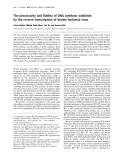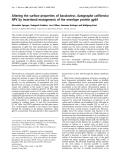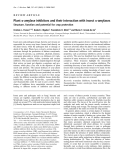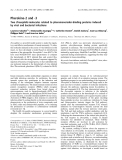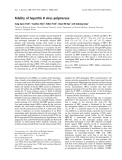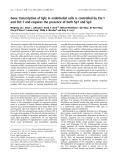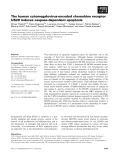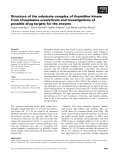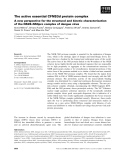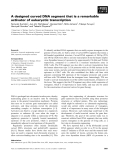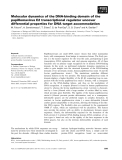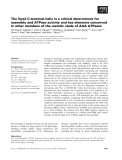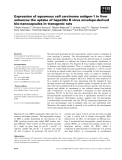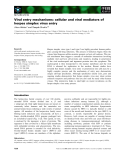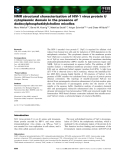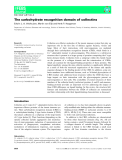
Bacteria and viruses
-
Hypoxia interrupts the initiation of simian virus 40 (SV40) replication in vivo at a stage situated before unwinding of the origin region. After re-oxygenation, unwinding followed by a synchronous round of viral replication takes place. To further characterize the hypoxia-induced inhibition of unwinding, we analysed the binding of several replication proteins to the viral minichromosome before and after re-oxygenation.
 11p
11p  research12
research12
 01-06-2013
01-06-2013
 41
41
 4
4
 Download
Download
-
We have recently expressed in bacteria the enzymatically active reverse transcriptase (RT) of bovine leukemia virus (BLV) [Perach, M. & Hizi, A. (1999) Virology 259, 176–189]. In the present study, we have studied in vitro two features of the DNA polymerase activity of BLV RT, the processivity of DNA synthesis and the fidelity of DNA synthesis. These properties were compared with those of the well-studied RTs of human immunodeficiency virus type 1 (HIV-1) and murine leukaemia virus (MLV).
 9p
9p  research12
research12
 01-06-2013
01-06-2013
 43
43
 4
4
 Download
Download
-
The envelope protein gp64 of the baculovirusAutographa californicanuclear polyhedrosis virus is essential for viral entry into insect cells, as the glycoprotein bothmediates pH-dependentmembrane fusionandbinds tohost cell receptors. Surface modification of baculovirus particles by genetic engineering of gp64 has been demonstrated by various strategies and thus has become an important and powerful tool in molecular biology.
 10p
10p  research12
research12
 23-04-2013
23-04-2013
 28
28
 2
2
 Download
Download
-
Insect pests and pathogens (fungi, bacteria and viruses) are responsible for severe crop losses. Insects feed directly on the plant tissues, while the pathogens lead to damage or death of the plant. Plants have evolved a certain degree of resistance through the production of defence compounds, which may be aproteic, e.g. antibiotics, alkaloids, terpenes, cyanogenic glucosides or proteic, e.g. chitinases,b-1,3-glu-canases, lectins, arcelins, vicilins, systemins and enzyme inhibitors.
 16p
16p  research12
research12
 23-04-2013
23-04-2013
 45
45
 3
3
 Download
Download
-
The activity of m-calpain, a heterodimeric, Ca 2+ -dependent cysteine protease appears to be modulated by membrane interactions involving oblique-orientated a-helix formation by a segment, GTAMRILGGVI, in the protein’s smaller subunit. Here, graphical and hydrophobic moment-based analyses predicted that this segment may form ana-helix with strong structural resemblance to the influenza virus peptide, HA2, a known oblique-orientateda-helix former.
 9p
9p  tumor12
tumor12
 22-04-2013
22-04-2013
 35
35
 5
5
 Download
Download
-
Drosophilais a powerful model system to study the regula-tory and effector mechanisms of innate immunity. To iden-tify molecules induced in the course of viral infection in this insect, we have developed a model based on intrathoracic injection of the picorna-like DrosophilaCvirus(DCV).We have used MALDI-TOF mass spectrometry to compare the hemolymph of DCV infected flies and control flies. By contrast with the strong humoral response triggered by injectionof bacteriaor fungal spores, we have identifiedonly one molecule induced in the hemolymph of virus infected flies....
 10p
10p  tumor12
tumor12
 20-04-2013
20-04-2013
 27
27
 3
3
 Download
Download
-
Neutralizing and protective monoclonal antibodies (mAbs) were used to fine-map the highlyconserved hemagglutinin noose epitope (H379–410, HNE) of themeasles virus. Short peptides mimicking this epitope were previouslyshown to induce virus-neutralizing antibodies [El Kasmi et al. (2000) J. Gen. Virol.81, 729–735]. The epitope contains three cys-teine residues, two of which (Cys386 and Cys394) form a disulfide bridge critical for antibodybinding.
 13p
13p  tumor12
tumor12
 20-04-2013
20-04-2013
 37
37
 5
5
 Download
Download
-
Although efficient vaccines are available, chronic hepatitis B (HBV) infection poses a major health problem worldwide, and prolonged treatment of chronicallyinfected HBV patients with nucleoside analogs often results in drug-resistantHBVvariants.Therefore, it is critical toevaluate the contribution of the HBV polymerase to mutations. FLAG-taggedwild-type (FPolE) andmutant (FPolE/D551A)HBV polymerases have been expressed in insect cells and purified. The purified FPolE showed DNA polymerase activity, but FPolE/D551A did not, implying that the activity was derived from FPolE....
 8p
8p  fptmusic
fptmusic
 16-04-2013
16-04-2013
 41
41
 3
3
 Download
Download
-
The immune coagulant fgl2/fibroleukin has been previously shown to play a pivotal role in the pathogenesis of murine and human fulminant hepatitis and fetal loss syndrome. Constitutive expression of fgl2 transcripts at low levels are seen in cytotoxic T cells, endothelial, intestinal and tropho-blast cells, while specific factors (such as virus and cytokines) are required to induce high levels of fgl2 expression in other cell types including monocytes/macrophages.
 13p
13p  fptmusic
fptmusic
 16-04-2013
16-04-2013
 38
38
 5
5
 Download
Download
-
Viral subversion of apoptosis regulation plays an important role in the outcome of host⁄virus interactions. Although human cytomegalovirus (HCMV) encodes several immediate early (IE) antiapoptotic proteins (IE1, IE2, vMIA and vICA), no proapoptotic HCMV protein has yet been iden-tified. Here we show that US28, a functional IE HCMV-encoded chemo-kine receptor, which may be involved in both viral dissemination and immune evasion, constitutively induces apoptosis in several cell types.
 15p
15p  fptmusic
fptmusic
 11-04-2013
11-04-2013
 38
38
 1
1
 Download
Download
-
Thymidine kinases have been found in most organisms, from viruses and bacteria to mammals.Ureaplasma urealyticum(parvum), which belongs to the class of cell-wall-lacking Mollicutes, has no de novosynthesis of DNA precursors and therefore has to rely on the salvage pathway. Thus, thymi-dine kinase (Uu-TK) is the key enzyme in dTTP synthesis.
 8p
8p  dell39
dell39
 27-03-2013
27-03-2013
 33
33
 2
2
 Download
Download
-
The NS2B–NS3 protease complex is essential for the replication of dengue virus, which is the etiologic agent of dengue and hemorrhagic fevers, dis-eases that are a burden for the tropical and subtropical areas of the world. The active form of the NS3 protease linked to the 40 residues of the NS2B cofactor shows highly flexible and disordered region(s)...
 13p
13p  inspiron33
inspiron33
 25-03-2013
25-03-2013
 44
44
 4
4
 Download
Download
-
To identify artificial DNA segments that can stably express transgenes in the genome of host cells, we built a series of curved DNA segments that mimic a left-handed superhelical structure. Curved DNA segments of 288 bp (T32) and 180 bp (T20) were able to activate transcription from the herpes simplex virus thymidine kinase (tk) promoter by approximately 150-fold and 70-fold, respectively, compared to a control in a transient transfection assay in COS-7 cells.
 12p
12p  inspiron33
inspiron33
 23-03-2013
23-03-2013
 45
45
 4
4
 Download
Download
-
Papillomaviruses are small DNA tumor viruses that infect mammalian hosts, with consequences from benign to cancerous lesions. The Early pro-tein 2 is the master regulator for the virus life cycle, participating in gene transcription, DNA replication, and viral episome migration.
 11p
11p  galaxyss3
galaxyss3
 19-03-2013
19-03-2013
 33
33
 3
3
 Download
Download
-
The Vps4 C-terminal helix is a critical determinant for assembly and ATPase activity and has elements conserved in other members of the meiotic clade of AAA ATPasesSorting of membrane proteins into intralumenal endosomal vesicles, mul-tivesicular body (MVB) sorting, is critical for receptor down regulation, antigen presentation and enveloped virus budding. Vps4 is an AAA ATPase that functions in MVB sorting. Although AAA ATPases are oligo-meric, mechanisms that govern Vps4 oligomerization and activity remain elusive. Parimala R. Vajjhala1,2, Chau H. Nguyen1,2, Michael J.
 23p
23p  media19
media19
 06-03-2013
06-03-2013
 57
57
 4
4
 Download
Download
-
We previously developed the bio-nanocapsule, which consists of hepatitis B virus envelope L proteins. The bio-nanocapsule can be used to deliver genes and drugs specifically to the human liver-derived tissues in xenograft models, presumably by utilizing the human liver-specific mechanism of hepatitis B virus infection.
 11p
11p  vinaphone15
vinaphone15
 28-02-2013
28-02-2013
 35
35
 2
2
 Download
Download
-
Báo cáo khoa học: Viral entry mechanisms: cellular and viral mediators of herpes simplex virus entry
Herpes simplex virus type-1 and type-2 are highly prevalent human patho-gens causing life-long infections. The process of infection begins when the virions bind heparan sulfate moieties present on host cell surfaces. This ini-tial attachment then triggers a cascade of molecular interactions involving multiple viral and host cell proteins and receptors, leading to penetration of the viral nucleocapsid and tegument proteins into the cytoplasm.
 9p
9p  viettel02
viettel02
 20-02-2013
20-02-2013
 50
50
 3
3
 Download
Download
-
The HIV-1 encoded virus protein U (VpU) is required for efficient viral release from human host cells and for induction of CD4 degradation in the endoplasmic reticulum. The cytoplasmic domain of the membrane protein VpU (VpUcyt) is essential for the latter activity. The structure and dynam-ics of VpUcyt were characterized in the presence of membrane simulating dodecylphosphatidylcholine (DPC) micelles by high-resolution liquid state NMR.
 16p
16p  viettel02
viettel02
 20-02-2013
20-02-2013
 48
48
 3
3
 Download
Download
-
Collectins are effector molecules of the innate immune system that play an important role in the first line of defence against bacteria, viruses and fungi. Most of their interactions with microorganisms are mediated through their carbohydrate recognition domain (CRD), which binds in a Ca 2+ -dependent manner to glycoconjugates. Molecular
 12p
12p  cosis54
cosis54
 09-12-2012
09-12-2012
 34
34
 2
2
 Download
Download
CHỦ ĐỀ BẠN MUỐN TÌM









